Table of Contents
Building on the knowledge of light and its properties from previous chapters, students explore their application to the human eye in Class 10 Science Chapter 11, “The Human Eye and the Colourful World.” This chapter, covered in detail in the human eye and colourful world class 10 notes, also delves into various optical phenomena, including the nature and formation of rainbows, the splitting of white light, and the reason behind the blue color of the sky.
In the human eye and the colourful world class 10 notes, students will find comprehensive explanations of how the eye functions, including the structure of the eye, the process of image formation, and common vision defects such as myopia and hypermetropia, along with their corrections.
Additionally, these class 10 science human eye and colourful world notes provide insights into the dispersion of light and the formation of phenomena like the twinkling of stars and the appearance of the sky in different colors at various times of the day. These class 10 science chapter 11 notes are invaluable for students preparing for their exams, offering clear and concise explanations to enhance their understanding and retention of key concepts.
Human Eye And Colourful World Class 10 Science Chapter 11 Notes
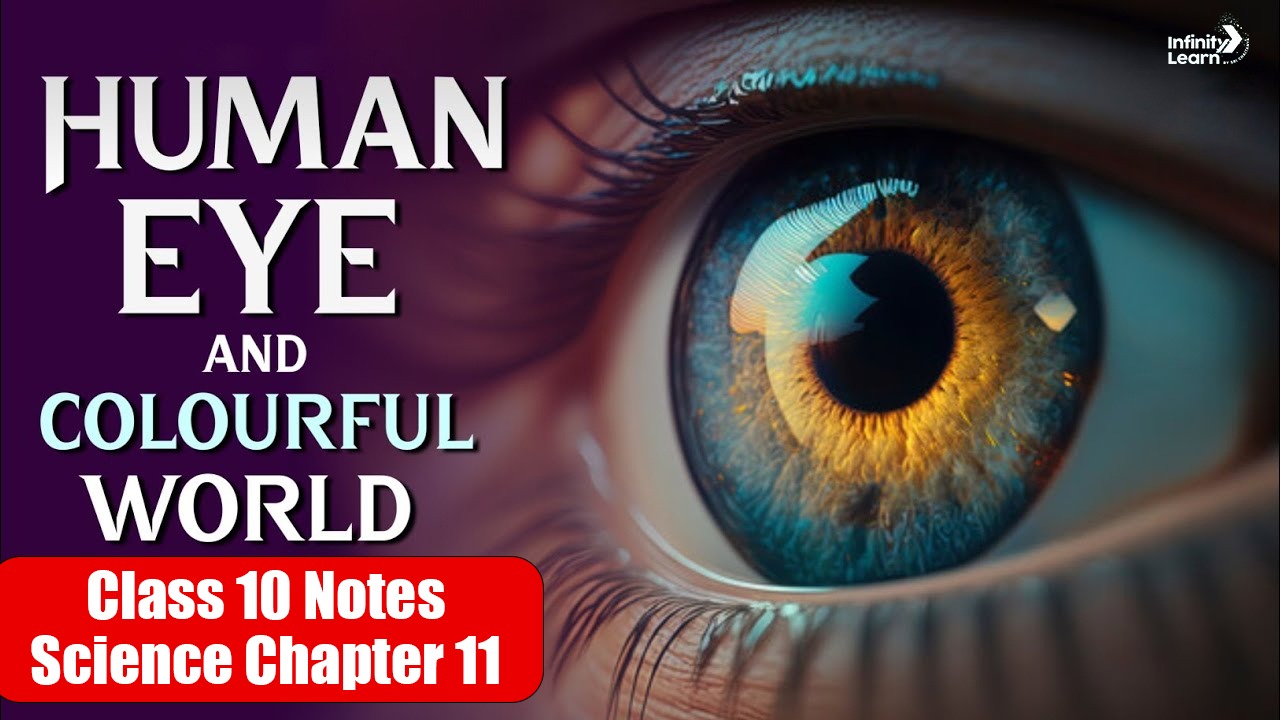
The Human Eye: It is a natural optical instrument which is used to see the objects by human beings. It is like a camera which has a lens and screen system.
Structure of the Human Eye
Of all the sense organs, the human eye is the most significant as it enables us to see the beautiful, colorful world around us. The eye is spherical in shape, with an average diameter of 2.3 cm. The internal structure of the eye includes the cornea, iris, pupil, lens, ciliary muscles, retina, nerve cells, optic nerve, yellow spot, aqueous and vitreous humor, and suspensory ligament.
The lens system of the human eye forms an image on the light-sensitive screen called the retina. The cornea is the thin membrane through which light enters the eye, and most of the light refraction occurs at its outer surface. Behind the cornea is the iris, a dark muscular diaphragm that controls the size of the pupil. The pupil regulates the amount of light entering the eye. Upon illumination, light-sensitive cells are triggered and induce electrical signals. These signals are sent to the brain through the optic nerve. The brain analyzes these signals and processes the information, allowing us to perceive objects as they are.
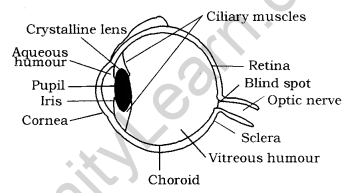
Also Check: Metals and Non-Metals Chapter Wise Important Questions Class 10 Science
The various parts of eye and their functions :
- Retina: It is a light sensitive screen inside the eye on which image is formed. It contains rods and cones.
- Cornea: It is a thin membrane which covers the eye trail. It acts like a lens which refracts the light entering the eye.
- Aqueous humour: It is fluid which fills the space between cornea and eye lens.
- Eye lens: It is a convex lens made of transparent and flexible jelly like material. Its curvature can be adjusted with the help of ciliary muscles.
- Pupil: It is a hole in the middle of iris through which light enters the eye. It appears black because light falling on it goes into the eye and does not come back.
- Ciliary muscles: These are the muscles which are attached to eye lens and can modify the shape of eye lens which leads to the variation in focal lengths.
- Iris: It controls the amount of light entering the eye by changing the size of the pupil.
- Optical nerve: These are the nerves which take the image to the brain in the form of electrical signals.
The human eye is roughly spherical in shape with a diameter of about 2.3 cm. It consists of a convex lens made up of living tissues. Hence, human lenses are living organs contrary to the simple optical lenses. The following table lists the main parts of the human eye and their respective functions.

Also Check: Our Environment Chapter Wise Important Questions Class 10 Science
| S.No. | Human Eye Part | Functions |
| 1. | Pupil | Opens and closes in order to regulate and control the amount of light. |
| 2. | Iris | Controls light level similar to the aperture of a camera. |
| 3. | Sclera | Protects the outer coat. |
| 4. | Cornea | A thin membrane which provides 67% of the eye’s focusing power. |
| 5. | Crystalline lens | Helps to focus light into the retina. |
| 6. | Conjunctive | Covers the outer surface (visible part) of the eye. |
| 7. | Aqueous humour | Provides power to the cornea. |
| 8. | Vitreous humour | Provides the eye with its form and shape. |
| 9. | Retina | Captures the light rays focussed by the lens and sends impulses to the brain via the optic nerve. |
| 10. | Optic nerve | Transmits electrical signals to the brain. |
| 11. | Ciliary muscles | Contracts and extends in order to change the lens shape for focusing. |
How Pupil Works?
For Example, You would have observed that when you come out of the cinema hall after watching the movie in the bright sunlight, your eyes get closed. And when you entered the hall from the bright light, you won’t be able to see and after some time you would be able to see. Here, the pupil of an eye provides a variable aperture, whose size is controlled by iris.
(a) When the light is bright: Iris contracts the pupil, so that less light enters the eye.
(b) When the light is dim: Iris expands the pupil, so that more light enters the eye. Pupil opens completely when iris is relaxed.
Also Check: Important Questions for Class 10 Science
Persistence of Vision: It is the time for which the sensation of an object continue in the eye. It is about 1/16th of a second.
Power of Accommodation: The ability of the eye lens to adjust its focal length accordingly as the distances is called power of accommodation.
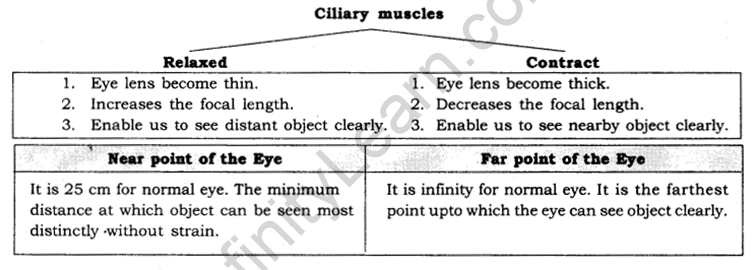
Colour Blindness: A person having defective cone cells is not able to distinguish between the different colours. This defect is known as Colour Blindness.
Defects of Vision and their Correction
Myopia (Short-sightedness)
It is a kind of defect in the human eye due to which a person can see near objects clearly but he cannot see the distant objects clearly. Myopia is due to
(i) excessive curvature of the cornea.
(ii) elongation of eyeball.

Also Check: NCERT Solutions for Class 10 Science Updated for 2023-24 Free PDF
Correction: Since a concave lens has an ability to diverge incoming rays, it is used to correct this defect of vision. The image is allowed to format the retina by using a concave lens of suitable power as shown in the given figure.
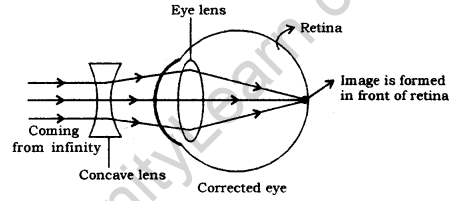
Hypermetropia (Long-sightedness)
It is a kind of defect in the human eye due to which, a person can see distant objects properly but cannot see the nearby objects clearly. It happens due to
(i) decrease in the power of eye lens i.e., increase in focal length of eye lens.
(ii) shortening of eyeball.
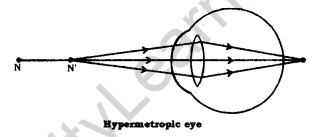
A hypermetropic eye has its least distance of distinct vision greater than 25 cm.

Correction: Since a convex lens has the ability to converge incoming rays, it can be used to correct this defect of vision, as you already have seen in the animation. The ray diagram for the corrective measure for a hypermetropic eye is shown in the given figure.
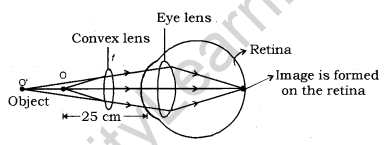
Power of the correcting convex lens
The Lens formula, \(\frac { 1 }{ v } -\frac { 1 }{ u } =\frac { 1 }{ f }\) can be used to calculate the focal length and hence, the power of the myopia correcting lens.
In this case,
Object distance, u = ∞
Image distance, v =
person’s far point Focal length, f =?
Hence, lens formula becomes
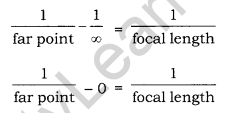
In case of a concave lens, the image is formed in front of the lens i.e., on the same side of the object.
Focal length = -Far point
Now, power of the required lens (P) = \(\frac { 1 }{ f(in m) }\)
Power of the correcting convex lens
Lens formula, \(\frac { 1 }{ v } -\frac { 1 }{ u } =\frac { 1 }{ f }\) can be used to calculate focal length f and hence, power P of the correcting convex lens, where,
Object distance, u = -25 cm, normal near point
Image distance, v = defective near point
Hence, the lens formula is reduced to
\(\frac { 1 }{ v } +\frac { 1 }{ 25 } =\frac { 1 }{ f }\)
Presbyopia
It is a kind of defect in human eye which occurs due to ageing. It happens due to the following reasons
(i) decrease in flexibility of eye lens.
(ii) gradual weakening of ciliary muscles.
In this, a person may suffer from both myopia and hypermetropia.
Correction: By using a bifocal lens with appropriate power. Bifocal lenses consist of both concave and convex lens, upper position consists of the concave lens and lower portion consists of a convex lens.
Astigmatism: It is a kind of defect in human eye due to which a person cannot see (focus) simultaneously horizontal and vertical lines both.
Correction: By using a cylindrical lens.
Cataract: Due to the membrane growth over eye lens, the eye lens becomes hazy or even opaque. This leads to a decrease or loss of vision. This problem is called a cataract. It can be corrected only by surgery.
Refraction of light through a prism, Dispersion of white light by a glass prism, Composition of white light, Recombination of spectrum colours, Rainbow.
Refraction of light through a prism: When a ray of light is incident on a rectangular glass slab, after refracting through the slab, it gets displaced laterally. As a result, the emergent ray comes out parallel to the incident ray.
Unlike a rectangular slab, the side of a glass prism are inclined at an angle called the angle of prism.
Prism: A prism has two triangular bases and three
Angle of Prism: Angle between two lateral faces is
Angle of Deviation: The angle between the incident deviation.
Dispersion of white light by a glass prism: The phenomenon of splitting of white light into its seven constituent colours when it passes through a glass prism is called dispersion of white light. The various colours seen are Violet, Indigo, Blue, Green, Yellow, Orange and Red. The sequence of colours remembers as VIBGYOR. The band of seven colours is called the spectrum. The different component colour of light bends at a different angle with respect to the incident angle. The violet light bends the least while the red bends most.
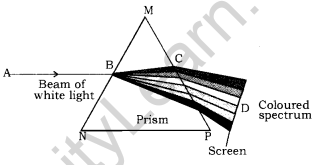
Composition of white light: White light consists of seven colours i.e., violet, indigo, blue, green, yellow, orange and red.
Monochromatic light: Light consisting of single colour or wavelength is called monochromatic light, example; sodium light.
Polychromatic light: Light consisting of more than two colours or wavelengths is called polychromatic light, example; white light.
Recombination of white light: Newton found that when an inverted prism is placed in the path of dispersed light then after passing through the prism, they recombine to form white light.
Issac Newton: He was the first, who obtained spectrum of sunlight by using glass prism. He tried to split the spectrum of white light more by using another similar prism, but he could not get any more colours.
He repeated the experiment using second prism in inverted position with respect to the first prism. It allowed all the colours of spectrum to pass through second prism. He found white light emerges on the other side of second prism.
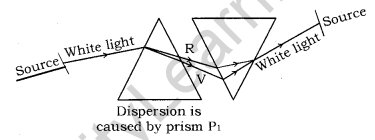
He concluded that Sun is made up of seven visible colour VIBGYOR.
Rainbow: It is the spectrum of sunlight in nature. It is formed due to the dispersion of sunlight by the tiny water droplet, present in the atmosphere.
Formation of the rainbow: The water droplets act like small prism. They refract and disperse the incident sunlight, then reflect it internally, and finally refract it again when it comes out of the raindrop. Due to the dispersion of light and internal reflection, different colours reach the observer’s eye.

Red colour appears on top and violet at the bottom of rainbow.
A rainbow is always formed in a direction opposite to that of Sun.
At ‘A’ – Refraction and dispersion take place.
At ‘B’ – Internal reflection takes place.
At ‘C’ – Refraction and dispersion take place.
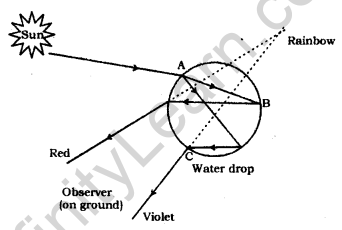
Atmospheric Refraction: The refraction of light caused by the Earth’s atmosphere (having air layers of varying optical densities) is called Atmospheric Refraction.
Appearance of Star Position: It is due to atmospheric refraction of star light.
The temperature and density of different layer of atmosphere keeps varying. Hence, we have different medium.
Distant star act as point source of light. When the starlight enter the Earth’s atmosphere, it undergoes refraction continuously, due to changing refractive index i.e. from Rarer to denser. It bends towards the normal.
Due to this, the apparent position of the star is different from actual position. The star appear higher than its actual position.
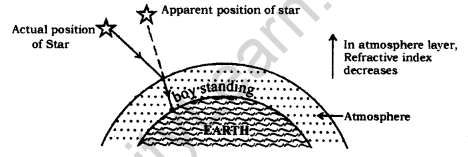
Twinkling of Star: It is also due to atmospheric refraction.
Distant star act like a point source of light. As the beam of starlight keeps deviating from its path, the apparent position of star keeps on changing because physical condition of earth’s atmosphere is not stationary.
Hence, the amount of light enters our eyes fluctuate sometimes bright and sometime dim. This is the “Twinkling effect of star”.

Why planets do not twinkle ?
Planets are closer to earth and are seen as extended source of light i.e. the collection of large number of point sized sources of light. Therefore the total amount of light entering our eyes from all individual point source will nullify the twinkling effect.
Why, the duration of day becomes approximately 4 minutes shorter if there is no atmosphere on earth: Actual sun rise happens when it is below the horizon in the morning. The rays of light from the sun below the horizon reach our eyes because of refraction of light. Similarly, the sun can be seen about few minutes after the actual sun set. Thus the duration of, day time will increase by 4 minutes.
This is due to atmospheric refraction. Because of this sun is visible about 2 minutes earlier than actual sunrise and about 2 minutes after the actual sun set.
Apparent flattering of the Sun’s disc at sunset and sunrise is due to atmospheric refraction.
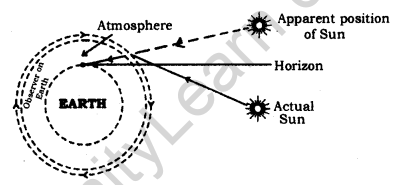
Scattering of light: According to Rayleigh’ Law of Scattering, the amount of scattered light ∝ \(\frac { 1 }{ { \lambda }^{ 4 } }\) (λ = wavelength)
Scattering of light decreases with increase in wavelength.
Tyndall Effect: When a beam of light strikes, the minute particle of earth’s atmosphere, suspended particles of dust and molecule of air the path of beam become visible. The phenomenon of scattering of light by the colloidal particle gives rise to Tyndall Effect.
- It can be observed when sunlight passes through a canopy of a dense forest.
- The colour of the scattered light depends on the size of the scattering particles.

Colour of Sunrise and Sunset: While sunset and sunrise, the colour of the sun and its surroundihg appear red. During sunset and sunrise, the sun is near to horizon, and therefore, the sunlight has to travel larger distance in atmosphere. Due to this, most of the blue light (shorter wavelength) is scattered away by the particles. The light of longer wavelength (red colour) reaches our eye. This is why sun appear red in colour.
Why the danger signal or sign is made of red colour?
Red colour scatteres the most when strikes the small particle of fog and smoke because it has the maximum wavelength (visible spectrum). Hence, from large distance also, we can see the red colour clearly.
At noon sun appears white: At noon, the sun is overhead and sunlight would travel shorter distance relatively through the atmosphere. Hence, at noon, the sun appear white as only little of the blue and violet colours are scattered.
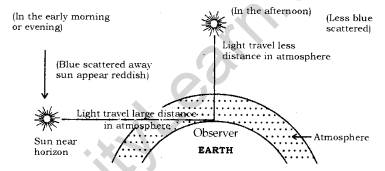
Human Eye: It is a wonderful gift of nature to the human body. Human eye is nearly spherical in shape of diameter about 2.5 cm.
Parts of Human Eye
- Cornea: It is the protective and front layer of the eye. It is made by a transparent membrane. Light enters the eye through the cornea.
- Iris: Dark and a colourful muscular diaphragm is called iris. It is responsible for colour of the eye.
- Pupil: Small circular hole in the centre of iris. It regulates the amount of light entering the eye by adjusting the size of the iris.
- Ciliary Muscles: It holds the eye lens at its proper position. It changes the size of eye lens.
- Eye lens: The eye lens is a convex lens made by the transparent jelly like material.
- Retina: It is the screen of the eye. A real and inverted image form on the retina.
- Rods and Cones: These are colour sensitive rods and cones shaped cells. Rods are responsible for the vision in dim light while cones are responsible for colour.
- Optic Nerve: It converts information of the image into a corresponding electric signal and passes it to the brain.
- Blind Spot: The junction of the optic nerve and retina, where no rods and cones cells are present is called the blind spot. It is insensitive to light.
Near Point: The nearest point from eye at which the eye can see clearly without strain is called near point. For normal eye it is 25 cm.
Far Point: The farthest point, upto which the eye can see the object clearly is called far point. For normal eye it is infinity.
The range of Vision: Distance between near point and far point of eye is called range of vision.
Power of Accommodation: The ability of the eye to see near as well as far objects clearly is called Power of Accommodation.
Myopia (Nearsightedness): In this defect, the eye is unable to see far off objects clearly but is able to see near objects clearly.
Reason.
- Due to increase in size of eye ball
- Due to excessive curvature of cornea
- Due to increase in power (or decrease in focal length) of eye lens.
Correction: It is corrected by using concave lens of suitable focal length.
Hypermetropia (Far sightedness): In this defect eye is unable to see nearby objects clearly but is able to see far objects clearly.
Reason.
- Due to decrease in size of eye ball
- Due to decrease in power (or increase in focal length) of eye lens.
Correction: It is corrected by using a convex lens of suitable focal length.
Dispersion of Light: Splitting of white light into seven colours is called dispersion. Example, the formation of Rainbow (VIBGYOR). Violet deviates the most but red deviates least.
1. The human eye is one of the most valuable and sensitive sense organs. It enables us to see the wonderful world and the colours around us.
2. The eyeball is approximately spherical in shape with a diameter of about 2.3 cm.
3. Most of the refraction for the light rays entering the eye occurs at the outer surface of the cornea. The crystalline lens merely provides the finer adjustment of focal length required to focus.
4. The human eye has the following parts :
- Cornea : The transparent spherical membrane covering the front of the eye.
- Iris: The coloured diaphragm between the cornea and lens.
- Pupil: The small hole in the iris.
- Eye lens : It is a transparent lens made of jelly like material.
- Ciliary muscles: These muscles hold the lens in position.
- Retina: The back surface of the eye.
- Blind spot: The point at which the optic nerve leaves the eye. An image formed at this point is not sent to the brain.
- Aqueous humour: A clear liquid region between the cornea and the lens.
- Vitreous humour: The space between eye lens and retina is filled with another liquid called vitreous humour.
5. In the eye, the image is formed on the retina by successive refractions at the cornea, the aqueous humour, the lens and the vitreous humour. Electrical signals then travel along the optic nerve to the brain to be interpreted. In good light, the yellow spot is most sensitive to detail and the image is automatically formed there.
6. Accommodation: The ability of the eye to focus both near and distant objects, by adjusting its focal length, is called the accommodation of the eye or the ability of the ciliary muscles to change the focal length of the eye lens is called accommodation.
7. Defects of the Eye : Although the eye is one of the most remarkable organs in the body, it may have several abnormalities, which can often be corrected with eyeglasses, contact lenses, or surgery. The various defects from which an eye can suffer are (i) Hypermetropia or long sightedness, (ii) Myopia or shortsightedness and (iii) Astigmatism, (iv) Presbyopia.
8. Hypermetropia, hyperopia, or long sightedness : A person suffering from this defect can see distant objects I clearly but cannot see nearby objects clearly. In this defect, the near point lies farther away than 25 cm. Hypermetropia (far sightedness — the image of nearby objects is focussed beyond the retina) is corrected by using a convex lens of suitable power. The eye loses
its power of accommodation at old age.
9. Hypermetropia is due to the following reasons :
- Either the hyperopic eyeball is too short or
- The ciliary muscle is unable to change the shape
of the lens enough to properly focus the image i.e. the focal length of the eye lens increases.
10. Myopia or short sightedness or near sightedness: A person suffering frommyopia or short sightedness can see nearby objects clearly but cannot see the far away objects clearly. Myopia (short sightedness — the image of distant objects is focussed before the retina) is corrected by using a concave lens of suitable power.
11. This defect is due to the following reasons :
- Either the eyeball is longer than normal or
- The maximum focal length (due to excessive curvature of the cornea) of the lens is insufficient to produce a clearly formed image on the retina.
12. A person may also have an eye defect known as astigmatism, in which light from a point-source produces a line image on the retina. A person suffering from this defect cannot see in all directions equally well i.e., he cannot see the vertical and horizontal lines simultaneously. This condition arises either when the cornea or the crystalline lens or both are not perfectly spherical. Astigmatism can be corrected with lenses having different curvatures in two mutually perpendicular directions i.e., cylindrical lens.
13. When a person suffers from both, the myopia as well as Hypermetropia, his spectacles for correction have bifocal lenses. The upper half is a concave lens for distant vision and lower half is a convex lens for reading.
14. Presbyopia is that defect of human eye, due to which an old person cannot read and write comfortably. That is why Presbyopia is also called old sight.
15. To correct Presbyopia, an old person has to use spectacles with a convex lens of suitable focal length, or power as explained already.
16. The cause of Hypermetropia is decrease in length of eyeball or increase In focal length of eye lens. But the cause of Presbyopia is only increase in focal length of eye lens. The eyeball, in Presbyopia, has normal length.
the vision of the eye decreases, leading sometimes to total loss of vision. The problem is overcome by cataract surgery i.e., removal of the eye lens, and its replacement by a lens of suitable focal length.
18. We need two eyes because a human being has a horizontal field of view of about 150° with one eye and of about 180° with two eyes. Thus, two eyes provide us wider horizontal field of view.
With one eye, the world looks flat, i.e., two dimensional only. With two eyes, the view is three dimensional, i.e., dimension of depth is added to our view.
19. As our two eyes are separated by a few centimetres, each eye observes a slightly different image. Our brain combines the two views into one and we get to know how close or far away the things seen are.
20. By donating our eyes after we die, one pair of our eyes can give vision to two corneal blind people. Eye donors may belong to any sex or any age group. People suffering from diabetes, hypertension, asthma or any other non- communicable diseases can donate eyes. People who have been using spectacles or those operated for cataract can also donate eyes.
21. The smallest distance, at which the eye can see objects clearly without strain, is called the near point of the eye or the least distance of distinct vision. For a young adult with normal vision, it is about 25 cm.
22. Persistence of vision of the eye: The image of an object persists on the retina for 1/16 second, even after the removal of the object. The sequence of still pictures taken by a movie camera is projected on a screen at a rate of about 24 images or more per second. The successive impressions of images on the screen appear to merge smoothly into one another to give us the feeling of moving images.
23. The large numbers of light sensitive cells contained in the retina of the eye are of two types: rod shaped cells which respond to brightness or intensity of light and cone shaped cells, which respond to colour of light. Thus/cone shaped cells enable us to distinguish between different colours.
24. When a person cannot distinguish between different colours, he is said to be colour blind though his vision may otherwise be normal. Colour blindness is a genetic disorder which occurs by inheritance. So far, there is no cure for colour blindness.
25. Farpoint: The farthest point upto which a short sighted eye can see clearly is called the far point of the eye. For a normal eye, the far point is infinity.
26. Near point : The nearest point upto which a long sighted eye can see clearly is called the near point of the eye. For a normal human eye, of an adult, the near point is about 25 cm from the eye.
27. Least cfistance of distinct vision: The minimum distance upto which an eye can see clearly is called the legist distance of distinct vision ; it is normally denoted by D. The least distance of distinct vision is equal to the distance between the eye and its near point. For a normal human eye, this distance is around 25 cm.
28. The distance between far point and near point of the eye is called range of vision of the eye.
29. When white light passes through a prism, the violet light bends most and the red light bends the least. Dispersion of light is the phenomenon of splitting of white light into its constituent seven colours on passing through a glass prism. The band of seven colours so obtained is called visible spectrum.
30. The seven colours of white light are violet, indigo, blue, green, yellow, orange and red. It is remembered by the acronym VIBGYOR.
31. Isaac Newton was the first to use a prism to obtain a spectrum of sunlight.
32. Spectrum is the band of distinct colours we obtain when white light is split by a prism.
33. Cause of dispersion : Every colour has its own characteristic wavelength/frequency. Different colours move with same speed in air/vacuum. But their speeds in refracting media like glass are different. Therefore, refractive index of the medium for different colours is different. As a result, different colours undergo different deviations on passing through the prism. Hence, different colours emerge from the prism along different directions.
34. The speed of light in vacuum is same for all wavelengths, but the speed in a material substance is different for different wavelengths.
35. In any medium other than air/vacuum red light travels the fastest and violet light travels the slowest.
36. The most familiar form of electromagnetic radiation may be defined as that part of the spectrum that the human eye can detect. Light is produced by the rearrangement of electrons in atoms and molecules. The various wavelengths of visible light are classified with colours ranging from violet (λ = 4 x 10-7 m) to red (λ = 7 x 10-7 m). The eye’s sensitivity is a function of wavelength, the sensitivity being a maximum at a wavelength of about λ = 5.6 x 10-7 m (yellow-green).
37. When we pass white light through two ideptical prisms held side by side with their refracting edges in opposite directions; the first prism disperses white light into seven colours and the second prism recombines the seven colours into white light. Thus, light emerging from 2nd prism is white.
38. A rainbow is formed due to dispersion of light by tiny droplets of water which act as prisms.
39. Atmospheric refraction is the cause of twinkling of stars, advance sunrise and delayed sunset.
40. Scattering of light causes the blue colour of sky and the reddening of the Sun at sunrise and sunset.






